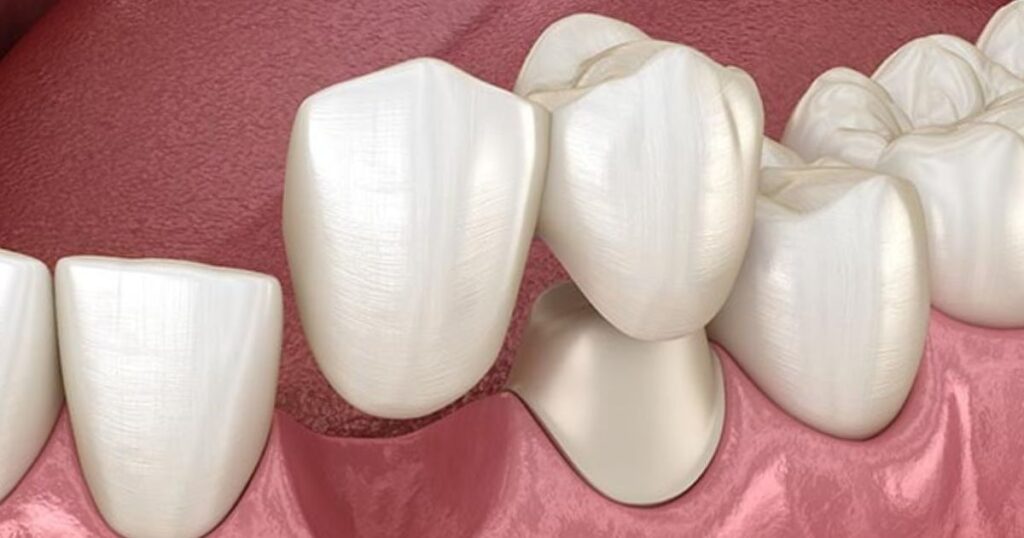Cantilever Bridges
- Home
- Dental Bridges
- Cantilever Bridges
Cantilever bridges are a popular dental prosthesis used to replace missing teeth. They are named after the cantilever design, which means that the bridge is supported on one side only. This design is ideal for replacing teeth that are not adjacent to other teeth and cannot be supported by traditional dental bridges. Cantilever bridges are made up of one or more artificial teeth, known as pontics, which are supported by a single abutment tooth or dental implant.

Cantilever dental bridges are typically used when a patient has a missing tooth that is not adjacent to other teeth. This could be due to a variety of reasons, such as a tooth that has been extracted or a congenitally missing tooth. In these cases, a traditional bridge cannot be used because there are no adjacent teeth to support it.
Dental cantilever bridges can also be used to support a dental implant. In this case, the pontic is attached to the implant, which is then anchored to the jawbone. This type of cantilever bridge is often used when a patient has a missing tooth in the front of the mouth, where aesthetics are particularly important.
The process of making a dental cantilever bridge typically involves several steps. First, the abutment tooth or implant is prepared to receive the bridge. This may involve removing some of the tooth structure or placing an abutment on top of the implant.
Next, impressions are taken of the prepared tooth or implant and the surrounding teeth. These impressions are used to create a model of the patient’s mouth, which is used to fabricate the bridge.
The bridge itself is typically made from a combination of metal and porcelain. The metal provides strength and stability, while the porcelain provides a natural-looking appearance.
Once the bridge has been fabricated, it is cemented onto the abutment tooth or implant using a dental adhesive.
Dental cantilever bridges offer several benefits over traditional bridges, including:
Preservation of tooth structure: With a traditional bridge, the adjacent teeth must be prepared to receive the bridge. This involves removing some of the tooth structure, which can weaken the teeth and make them more susceptible to decay. With a cantilever bridge, only one tooth or implant is prepared, which helps to preserve the surrounding teeth.
Aesthetics: Cantilever bridges can be designed to match the natural color and shape of the surrounding teeth, making them virtually indistinguishable from natural teeth.
Durability: Cantilever bridges are made from strong, durable materials, such as metal and porcelain, which can withstand the forces of chewing and biting.
Convenience: Cantilever bridges can be fabricated and placed in just a few visits to the dentist, making them a convenient option for patients.
While cantilever dental bridges offer many benefits, there are also some risks associated with this type of dental prosthesis. These include:
Increased risk of tooth fracture: Because only one tooth or implant is used to support the bridge, there is an increased risk of tooth fracture or damage. This risk is especially high if the patient has a history of clenching or grinding their teeth.
Gum recession: Cantilever bridges can put extra pressure on the abutment tooth or implant, which can lead to gum recession over time.
Difficulty with oral hygiene: Cleaning around a cantilever bridge can be more difficult than cleaning around natural teeth, which can increase the risk of tooth decay and gum disease.
Limited lifespan: Cantilever bridges may not last as long as other dental prostheses, such as dental implants or traditional bridges. This is due to the increased stress placed on the abutment tooth or implant.
Higher cost: Cantilever bridges can be more expensive than other dental prostheses due to the additional materials and labor required for their fabrication.
It is important to discuss the risks and benefits of cantilever bridges with your dentist before deciding whether this type of dental prosthesis is right for you.
Caring for a dental cantilever bridge is similar to caring for natural teeth. Regular brushing and flossing are important to prevent tooth decay and gum disease. It is also important to schedule regular dental check-ups and cleanings to ensure that the bridge is functioning properly and to identify any potential issues before they become more serious.
Patients with cantilever bridges should also avoid biting down on hard objects, as this can put additional stress on the bridge and increase the risk of tooth fracture. Additionally, patients who grind or clench their teeth may be advised to wear a nightguard to protect the bridge and surrounding teeth.
Dental cantilever bridges are a popular dental prosthesis used to replace missing teeth that are not adjacent to other teeth. They offer several benefits over traditional bridges, including preservation of tooth structure, aesthetics, durability, and convenience. However, there are also some risks associated with cantilever bridges, including increased risk of tooth fracture, gum recession, difficulty with oral hygiene, limited lifespan, and higher cost.
If you are considering a cantilever dental bridge, it is important to discuss the risks and benefits with your dentist to determine whether this type of dental prosthesis is right for you. With proper care and maintenance, a cantilever bridge can provide a durable and aesthetic solution for missing teeth.

